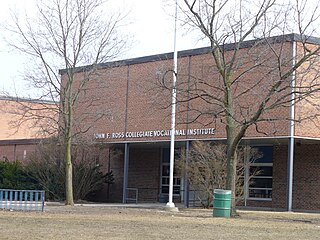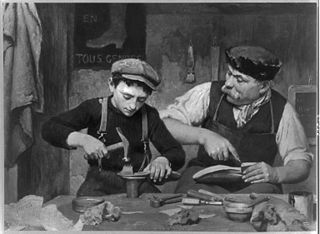Related Research Articles

Educational psychology is the branch of psychology concerned with the scientific studying of human learning. The study of learning processes, from both cognitive and behavioral perspectives, allows researchers to understand individual differences in intelligence, cognitive development, affect, motivation, self-regulation, and self-concept, and as these roles during learning. This field of educational psychology relies heavily on quantitative methods, including testing and measurement, to enhance educational activities related to instructional design, classroom management, and assessment, which serve to facilitate learning processes in various educational settings across the lifespan.

Vocational education is education that prepares people to work as a technician or to take up employment in a skilled craft or trade as a tradesperson or artisan. Vocational Education can also be seen as that type of education given to an individual to prepare that individual to be gainfully employed or self employed with requisite skill. Vocational education is known by a variety of names, depending on the country concerned, including career and technical education, or acronyms such as TVET and TAFE.
A teaching method comprises the principles and methods used by teachers to enable student learning. These strategies are determined partly on subject matter to be taught and partly by the nature of the learner. For a particular teaching method to be appropriate and efficient it has take into account the learner, the nature of the subject matter, and the type of learning it is supposed to bring about.

Apprenticeship is a system for training a new generation of practitioners of a trade or profession with on-the-job training and often some accompanying study. Apprenticeships can also enable practitioners to gain a license to practice in a regulated occupation. Most of their training is done while working for an employer who helps the apprentices learn their trade or profession, in exchange for their continued labor for an agreed period after they have achieved measurable competencies.

A teacher, also called a schoolteacher or formally an educator, is a person who helps students to acquire knowledge, competence, or virtue.
Education in the United Kingdom is a devolved matter with each of the countries of the United Kingdom having separate systems under separate governments: the UK Government is responsible for England; whilst the Scottish Government, the Welsh Government and the Northern Ireland Executive are responsible for Scotland, Wales and Northern Ireland, respectively.

Education in Germany is primarily the responsibility of individual German states, with the federal government playing a minor role. Optional Kindergarten education is provided for all children between one and six years old, after which school attendance is compulsory. Overall, Germany is one of the best performing OECD countries in reading literacy, mathematics and sciences with the average student scoring 515 in the PISA Assessment Test, well above the OECD average of 497 points. Germany has a less competitive system, leading to low rates of bullying and students having a weak fear of failure but a high level of self-confidence and general happiness compared to other OECD countries like South Korea. Additionally, Germany has one of the largest percentage of top performers in reading among socio-economically advantaged students, ranking 3rd out of 76 OECD countries. This leads to Germany having one of the highest-educated labour forces among OECD countries. The Human Rights Measurement Initiative finds that Germany is achieving 75.4% of what should be possible for the right to education, at their level of income.

A comprehensive school typically describes a secondary school for pupils aged approximately 11–18, that does not select its intake on the basis of academic achievement or aptitude, in contrast to a selective school system where admission is restricted on the basis of selection criteria, usually academic performance. The term is commonly used in relation to England and Wales, where comprehensive schools were introduced as state schools on an experimental basis in the 1940s and became more widespread from 1965. They may be part of a local education authority or be a self governing academy or part of a multi-academy trust.
The history of education in Africa can be roughly divided into pre- and post- colonial periods. Since the introduction of formal education to Africa by European colonists, African education, particularly in West and Central Africa, is characterised by both traditional African teachings and European-style schooling systems. The state of education reflects not only the effects of colonialism, but instability resulting from and exacerbated by armed conflicts in many regions of Africa as well as fallout from humanitarian crises such as famine, lack of drinking water, and outbreaks of diseases such as malaria and Ebola, among others. Although the quality of education and the quantity of well-equipped schools and teachers has steadily increased since the onset of the colonial period, there are still evident numerous inequalities in the existing educational systems based on region, economic status, and gender.

Teacher education or teacher training refers to programs, policies, procedures, and provision designed to equip (prospective) teachers with the knowledge, attitudes, behaviors, approaches, methodologies and skills they require to perform their tasks effectively in the classroom, school, and wider community. The professionals who engage in training the prospective teachers are called teacher educators.

Schooling in Capitalist America: Educational Reform and the Contradictions of Economic Life is a 1976 book by economists Samuel Bowles and Herbert Gintis. Widely considered a groundbreaking work in sociology of education, it argues the "correspondence principle" explains how the internal organization of schools corresponds to the internal organisation of the capitalist workforce in its structures, norms, and values. For example, the authors assert the hierarchy system in schools reflects the structure of the labour market, with the head teacher as the managing director, pupils fall lower down in the hierarchy. Wearing uniforms and discipline are promoted among students from working class, as it would be in the workplace for lower levels employees. Education provides knowledge of how to interact in the workplace and gives direct preparation for entry into the labour market.

Education in Ethiopia was dominated by the Ethiopian Orthodox Church for many centuries until secular education was adopted in the early 1900s. Prior to 1974, Ethiopia had an estimated illiteracy rate below 50% and compared poorly with the rest of Africa in the provision of schools and universities. After the Ethiopian Revolution, emphasis was placed on increasing literacy in rural areas. Practical subjects were stressed, as was the teaching of socialism. By 2015, the literacy rate had increased to 49.1%, still poor compared to most of the rest of Africa.

Education in Ivory Coast continues to face many challenges. Among sub-Saharan African countries, Ivory Coast has one of the highest literacy rates. According to The World Factbook - Central Intelligence Agency as of 2019, 89.9% of the population age 15 and over can read and write in Ivory Coast were respectively literate. The literacy rate for adults remains low: in 2000, it was estimated that only 48.7% of the total population was literate. Many children between 6 and 10 years are not enrolled in school, mainly children of poor families. The majority of students in secondary education are male. At the end of secondary education, students can sit the Baccalauréat examination. The country has universities in Abidjan, Bouaké, and Yamoussoukro.

Education in the Bahamas is compulsory between the ages of 5 and 16. As of 2003, the school attendance rate was 92% and the literacy rate was 95.5%. The government fully operates 158 of the 210 primary and secondary schools in The Bahamas. The other 55 schools are privately operated. Enrollment for state primary and secondary schools is 50,332, with more than 16,000 students attending private schools. Some public schools lack basic educational materials and are overcrowded. The Bahamas Union of Teachers (BUT) were the ones who acted to create some reform for their weakening education systems. The island has an Education Act that was revised in 1996 and is under control of the Prime Minister. As of 1996, the Education Act states that education is free for children between the ages of 5 and 16. The University of the Bahamas, established in Nassau in 1974, provides programs leading to bachelors and associate degrees. Several non-Bahamian colleges also offer higher education programs in The Bahamas. Generally, the academic year in The Bahamas goes from late August or early September to late May or early June for primary and secondary schools and late April/early May for college.

Evidence-based education (EBE) is the principle that education practices should be based on the best available scientific evidence, rather than tradition, personal judgement, or other influences. Evidence-based education is related to evidence-based teaching, evidence-based learning, and school effectiveness research. For example, research has shown that spaced repetition "leads to more robust memory formation than does massed training, which involves short or no intervals".
Spring Gardens Teacher Training College which initially was named The Female Teachers' Training School was one of the earliest normal schools in the Caribbean region. Located in Antigua it was opened as an informal women's training school in 1840, by Bishop George Westerby of the Moravian Church. The private school's goal was to train Caribbean women to teach other Caribbean women. It operated for 118 years, until 1958, and was the longest-lived training institution founded by missionaries in the region.

The history of state education in Queensland commences with the Moreton Bay penal settlement of New South Wales in Australia, which became the responsibility of the Queensland Government after the Separation of Queensland from New South Wales in 1859.
Southern University Laboratory School is a K-12 laboratory school in Baton Rouge, Louisiana, affiliated with Southern University.
Jenny Hammond is an Australian linguist. She is known for her research on literacy development, classroom interaction, and socio-cultural and systemic functional theories of language and learning in English as an Additional Language or dialect (EAL/D) education. Over the course of her career, Hammond's research has had a significant impact on the literacy development of first and second language learners, on the role of classroom talk in constructing curriculum knowledge and on policy developments for EAL education in Australia. She is an Honorary Associate Professor in the School of Education, University of Technology Sydney.

A teaching hospital is a hospital or medical centre that provides medical education and training to future and current health professionals. Teaching hospitals are almost always affiliated with one or more universities and are often co-located with medical schools.
References
- 1 2 Robinson, Wendy (2006). "Teacher Training in England and Wales: Past, Present and Future Perspectives" (PDF). Education Research and Perspectives. Crawley, Western Australia: The University of Western Australia. 33 (2): 21–22. ISSN 1446-0017. Archived from the original (PDF) on 7 January 2017. Retrieved 7 January 2017.
- ↑ Miller, Errol (1999). "Teacher Development in the Caribbean". Organization of American States. Washington, D. C.: Inter-American Collaboratory for the Teacher Profession. p. 11. Retrieved 2 January 2017.
- ↑ Steward, Lucy; Thomas, Elwyn, eds. (1996). Caribbean Issues and Developments: Teacher Education in the Commonwealth. London, England: Commonwealth Secretariat. pp. 40–41, 133. ISBN 978-0-85092-460-2.
- ↑ Fergus, Howard A. (2003). A History of Education in the British Leeward Islands, 1838-1945. Kingston, Jamaica: University of the West Indies Press. p. 98. ISBN 978-976-640-131-3.